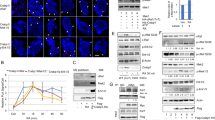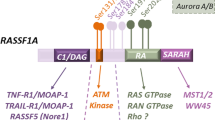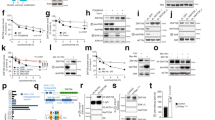Abstract
Retinoic acid (RA) regulates several gene programs by nuclear RA receptors (RARs) that are ligand-dependent transcriptional transregulators. The basic mechanism for switching on transcription of cognate-target genes involves RAR binding at specific response elements and a network of interactions with coregulatory protein complexes. In addition to these classical genomic effects, we recently demonstrated that RA also induces the rapid activation of the p38MAPK/MSK1 pathway, with characteristic downstream consequences on the phosphorylation of RARs and the expression of their target genes. Here, we aimed at deciphering the underlying mechanism of the rapid non-genomic effects of RA. We highlighted a novel paradigm in which a fraction of the cellular RARα pool is present in membrane lipid rafts, where it forms complexes with G protein alpha Q (Gαq) in response to RA. This rapid RA-induced formation of RARα/Gαq complexes in lipid rafts is required for the activation of p38MAPK that occurs in response to RA. Accordingly, in RA-resistant cancer cells, characterized by the absence of p38MAPK activation, RARα present in membrane lipid rafts does not associate with Gαq, pointing out the essential contribution of RARα/Gαq complexes in RA signaling.
This is a preview of subscription content, access via your institution
Access options
Subscribe to this journal
Receive 50 print issues and online access
$259.00 per year
only $5.18 per issue
Buy this article
- Purchase on Springer Link
- Instant access to full article PDF
Prices may be subject to local taxes which are calculated during checkout









Similar content being viewed by others
References
Alsayed Y, Uddin S, Mahmud N, Lekmine F, Kalvakolanu DV, Minucci S et al. (2001). Activation of Rac1 and the p38 mitogen-activated protein kinase pathway in response to all-trans-retinoic acid. J Biol Chem 276: 4012–4019.
Altucci L, Leibowitz MD, Ogilvie KM, de Lera AR, Gronemeyer H . (2007). RAR and RXR modulation in cancer and metabolic disease. Nat Rev Drug Discov 6: 793–810.
Bastien J, Rochette-Egly C . (2004). Nuclear retinoid receptors and the transcription of retinoid-target genes. Gene 328: 1–16.
Bour G, Gaillard E, Bruck N, Lalevee S, Plassat JL, Busso D et al. (2005). Cyclin H binding to the RAR{alpha} activation function (AF)-2 domain directs phosphorylation of the AF-1 domain by cyclin-dependent kinase 7. Proc Natl Acad Sci USA 102: 16608–16613.
Bruck N, Vitoux D, Ferry C, Duong V, Bauer A, de The H et al. (2009). A coordinated phosphorylation cascade initiated by p38MAPK/MSK1 directs RARalpha to target promoters. EMBO J 28: 34–47.
Chen N, Napoli JL . (2008). All-trans-retinoic acid stimulates translation and induces spine formation in hippocampal neurons through a membrane-associated RARalpha. FASEB J 22: 236–245.
Clagett-Dame M, Knutson D . (2011). Vitamin A in reproduction and development. Nutrients 3: 385–428.
de Laurentiis A, Donovan L, Arcaro A . (2007). Lipid rafts and caveolae in signaling by growth factor receptors. Open Biochem J 1: 12–32.
Dey N, De PK, Wang M, Zhang H, Dobrota EA, Robertson KA et al. (2007). CSK controls retinoic acid receptor (RAR) signaling: a RAR-c-SRC signaling axis is required for neuritogenic differentiation. Mol Cell Biol 27: 4179–4197.
Duong V, Rochette-Egly C . (2011). The molecular physiology of nuclear retinoic acid receptors. From health to disease. Biochim Biophys Acta 1812: 1023–1031.
Faria TN, Mendelsohn C, Chambon P, Gudas LJ . (1999). The targeted disruption of both alleles of RARbeta(2) in F9 cells results in the loss of retinoic acid-associated growth arrest. J Biol Chem 274: 26783–26788.
Gaub MP, Rochette-Egly C, Lutz Y, Ali S, Matthes H, Scheuer I et al. (1992). Immunodetection of multiple species of retinoic acid receptor alpha: evidence for phosphorylation. Exp Cell Res 201: 335–346.
Germain P, Chambon P, Eichele G, Evans RM, Lazar MA, Leid M et al. (2006a). International Union of Pharmacology. LX. Retinoic acid receptors. Pharmacol Rev 58: 712–725.
Germain P, Staels B, Dacquet C, Spedding M, Laudet V . (2006b). Overview of nomenclature of nuclear receptors. Pharmacol Rev 58: 685–704.
Gianni M, Bauer A, Garattini E, Chambon P, Rochette-Egly C . (2002). Phosphorylation by p38MAPK and recruitment of SUG-1 are required for RA-indced RARγ degradation and transactivation. EMBO J 21: 3760–3769.
Gianni M, Parrella E, Raska I, Gaillard E, Nigro EA, Gaudon C et al. (2006). P38MAPK-dependent phosphorylation and degradation of SRC-3/AIB1 and RARalpha-mediated transcription. EMBO J 25: 739–751.
Huhtakangas JA, Olivera CJ, Bishop JE, Zanello LP, Norman AW . (2004). The vitamin D receptor is present in caveolae-enriched plasma membranes and binds 1 alpha,25(OH)2-vitamin D3 in vivo and in vitro. Mol Endocrinol 18: 2660–2671.
Lai L, Yuan L, Chen Q, Dong C, Mao L, Rowan B et al. (2008). The G alpha i and G alpha q proteins mediate the effects of melatonin on steroid/thyroid hormone receptor transcriptional activity and breast cancer cell proliferation. J Pineal Res 45: 476–488.
Laudet V, Gronemeyer H . (2001). Nuclear Receptor Factsbook. Academic Press: London.
Le Romancer M, Treilleux I, Leconte N, Robin-Lespinasse Y, Sentis S, Bouchekioua-Bouzaghou K et al. (2008). Regulation of estrogen rapid signaling through arginine methylation by PRMT1. Mol Cell 31: 212–221.
Lefebvre P, Martin PJ, Flajollet S, Dedieu S, Billaut X, Lefebvre B . (2005). Transcriptional activities of retinoic acid receptors. Vitam Horm 70: 199–264.
Losel R, Wehling M . (2003). Nongenomic actions of steroid hormones. Nat Rev Mol Cell Biol 4: 46–56.
Luoma JI, Boulware MI, Mermelstein PG . (2008). Caveolin proteins and estrogen signaling in the brain. Mol Cell Endocrinol 290: 8–13.
Marquez DC, Chen HW, Curran EM, Welshons WV, Pietras RJ . (2006). Estrogen receptors in membrane lipid rafts and signal transduction in breast cancer. Mol Cell Endocrinol 246: 91–100.
Masia S, Alvarez S, de Lera AR, Barettino D . (2007). Rapid, nongenomic actions of retinoic acid on phosphatidylinositol-3-kinase signaling pathway mediated by the retinoic acid receptor. Mol Endocrinol 21: 2391–2402.
Matthews L, Berry A, Ohanian V, Ohanian J, Garside H, Ray D . (2008). Caveolin mediates rapid glucocorticoid effects and couples glucocorticoid action to the antiproliferative program. Mol Endocrinol 22: 1320–1330.
Migliaccio A, Piccolo D, Castoria G, Di Domenico M, Bilancio A, Lombardi M et al. (1998). Activation of the Src/p21ras/Erk pathway by progesterone receptor via cross-talk with estrogen receptor. EMBO J 17: 2008–2018.
Mizuno N, Itoh H . (2009). Functions and regulatory mechanisms of Gq-signaling pathways. Neurosignals 17: 42–54.
Norman AW, Henry HL, Bishop JE, Song XD, Bula C, Okamura WH . (2001). Different shapes of the steroid hormone 1alpha,25(OH)(2)-vitamin D(3) act as agonists for two different receptors in the vitamin D endocrine system to mediate genomic and rapid responses. Steroids 66: 147–158.
Norman AW, Mizwicki MT, Norman DP . (2004). Steroid-hormone rapid actions, membrane receptors and a conformational ensemble model. Nat Rev Drug Discov 3: 27–41.
Ordonez-Moran P, Larriba MJ, Palmer HG, Valero RA, Barbachano A, Dunach M et al. (2008). RhoA-ROCK and p38MAPK-MSK1 mediate vitamin D effects on gene expression, phenotype, and Wnt pathway in colon cancer cells. J Cell Biol 183: 697–710.
Ostrom RS, Insel PA . (2006). Methods for the study of signaling molecules in membrane lipid rafts and caveolae. Methods Mol Biol 332: 181–191.
Pan J, Kao YL, Joshi S, Jeetendran S, Dipette D, Singh US . (2005). Activation of Rac1 by phosphatidylinositol 3-kinase in vivo: role in activation of mitogen-activated protein kinase (MAPK) pathways and retinoic acid-induced neuronal differentiation of SH-SY5Y cells. J Neurochem 93: 571–583.
Park SS, Kim JE, Kim YA, Kim YC, Kim SW . (2005). Caveolin-1 is down-regulated and inversely correlated with HER2 and EGFR expression status in invasive ductal carcinoma of the breast. Histopathology 47: 625–630.
Pedram A, Razandi M, Sainson RC, Kim JK, Hughes CC, Levin ER . (2007). A conserved mechanism for steroid receptor translocation to the plasma membrane. J Biol Chem 282: 22278–22288.
Pike LJ . (2003). Lipid rafts: bringing order to chaos. J Lipid Res 44: 655–667.
Piskunov A, Rochette-Egly C . (2011). MSK1 and Nuclear Receptors Signaling. In: Vermeulen L and Arthur JSC (eds). MSKs. Landes Bioscience Books: Austin, TX, USA.
Qiu J, Bosch MA, Tobias SC, Grandy DK, Scanlan TS, Ronnekleiv OK et al. (2003). Rapid signaling of estrogen in hypothalamic neurons involves a novel G-protein-coupled estrogen receptor that activates protein kinase C. J Neurosci 23: 9529–9540.
Rochette-Egly C, Germain P . (2009). Dynamic and combinatorial control of gene expression by nuclear retinoic acid receptors. Nucl Receptor Signaling 7: e005.
Rochette-Egly C, Plassat JL, Taneja R, Chambon P . (2000). The AF-1 and AF-2 activating domains of retinoic acid receptor-alpha (RARalpha) and their phosphorylation are differentially involved in parietal endodermal differentiation of F9 cells and retinoid-induced expression of target genes. Mol Endocrinol 14: 1398–1410.
Samarut E, Rochette-Egly C . (2011). Nuclear retinoic acid receptors: conductors of the retinoic acid symphony during development. Mol Cell Endocrinol (e-pub ahead of print 8 April 2011).
Simons K, Toomre D . (2000). Lipid rafts and signal transduction. Nat Rev Mol Cell Biol 1: 31–39.
Soderberg O, Gullberg M, Jarvius M, Ridderstrale K, Leuchowius KJ, Jarvius J et al. (2006). Direct observation of individual endogenous protein complexes in situ by proximity ligation. Nat Methods 3: 995–1000.
Staubach S, Hanisch FG . (2011). Lipid rafts: signaling and sorting platforms of cells and their roles in cancer. Expert Rev Proteomics 8: 263–277.
Stuermer CA . (2011). Reggie/flotillin and the targeted delivery of cargo. J Neurochem 116: 708–713.
Sugawara Y, Nishii H, Takahashi T, Yamauchi J, Mizuno N, Tago K et al. (2007). The lipid raft proteins flotillins/reggies interact with G alpha q and are involved in Gq-mediated p38 mitogen-activated protein kinase activation through tyrosine kinase. Cell Signal 19: 1301–1308.
Taneja R, Rochette-Egly C, Plassat JL, Penna L, Gaub MP, Chambon P . (1997). Phosphorylation of activation functions AF-1 and AF-2 of RAR alpha and RAR gamma is indispensable for differentiation of F9 cells upon retinoic acid and cAMP treatment. EMBO J 16: 6452–6465.
Tari AM, Lim SJ, Hung MC, Esteva FJ, Lopez-Berestein G . (2002). Her2/neu induces all-trans retinoic acid (ATRA) resistance in breast cancer cells. Oncogene 21: 5224–5232.
Vasudevan N, Pfaff DW . (2008). Non-genomic actions of estrogens and their interaction with genomic actions in the brain. Front Neuroendocrinol 29: 238–257.
Waugh MG, Hsuan JJ . (2009). Preparation of membrane rafts. Methods Mol Biol 462: 403–414.
White CD, Coetsee M, Morgan K, Flanagan CA, Millar RP, Lu ZL . (2008). A crucial role for G alpha q/11, but not G alpha i/o or G alpha s, in gonadotropin-releasing hormone receptor-mediated cell growth inhibition. Mol Endocrinol 22: 2520–2530.
Yao Y, Hong S, Zhou H, Yuan T, Zeng R, Liao K . (2009). The differential protein and lipid compositions of noncaveolar lipid microdomains and caveolae. Cell Res 19: 497–506.
Zanotto-Filho A, Cammarota M, Gelain DP, Oliveira RB, Delgado-Canedo A, Dalmolin RJ et al. (2008). Retinoic acid induces apoptosis by a non-classical mechanism of ERK1/2 activation. Toxicol In Vitro 22: 1205–1212.
Acknowledgements
We are grateful to the members of the cell culture facilities for their help and to all the members of the team for their helpful discussions and suggestions. Special thanks to Nathalie Bruck for GTPases analysis and to Regis Lutzing for generating the RARγWT MEF rescue line. This work was supported by funds from CNRS, INSERM, the Agence Nationale pour la Recherche (ANR-05-BLAN-0390-02 and ANR-09-BLAN-0297-01), the Association pour la Recherche sur le Cancer (ARC-07-1-3169), the Fondation pour la Recherche Médicale (DEQ20090515423) and the Institut National du Cancer (INCa-PL09-194 and PL07-96099). AP was supported by the Fondation pour la Recherche Médicale and by the Lady TATA Memorial Trust.
Author information
Authors and Affiliations
Corresponding author
Ethics declarations
Competing interests
The authors declare no conflict of interest.
Rights and permissions
About this article
Cite this article
Piskunov, A., Rochette-Egly, C. A retinoic acid receptor RARα pool present in membrane lipid rafts forms complexes with G protein αQ to activate p38MAPK. Oncogene 31, 3333–3345 (2012). https://doi.org/10.1038/onc.2011.499
Received:
Revised:
Accepted:
Published:
Issue Date:
DOI: https://doi.org/10.1038/onc.2011.499
Keywords
This article is cited by
-
Cellular and micro-environmental responses influencing the antitumor activity of all-trans retinoic acid in breast cancer
Cell Communication and Signaling (2024)
-
A ligand-independent fast function of RARα promotes exit from metabolic quiescence upon T cell activation and controls T cell differentiation
Mucosal Immunology (2021)
-
Doxycycline, metronidazole and isotretinoin: Do they modify microRNA/mRNA expression profiles and function in murine T-cells?
Scientific Reports (2016)
-
Retinoid Chemoprevention: Who Can Benefit?
Current Pharmacology Reports (2015)
-
Activation of Akt pathway by transcription-independent mechanisms of retinoic acid promotes survival and invasion in lung cancer cells
Molecular Cancer (2013)



